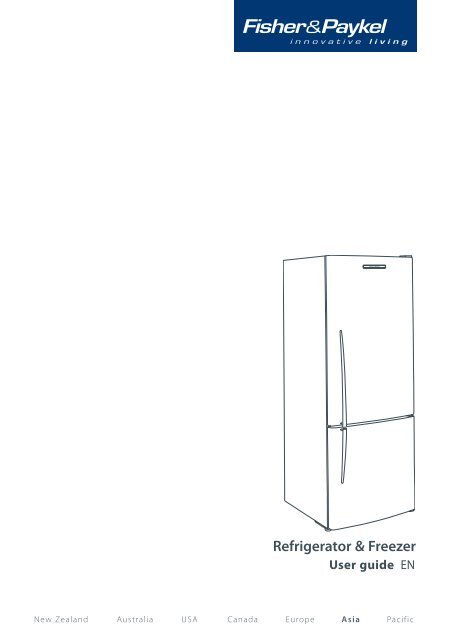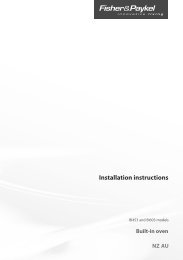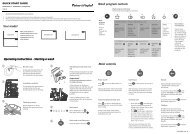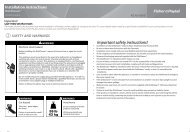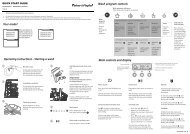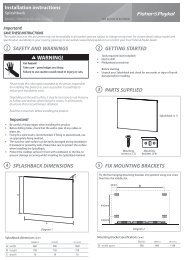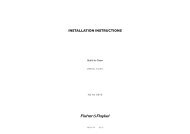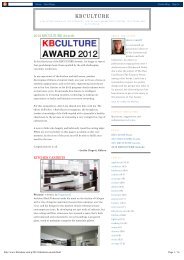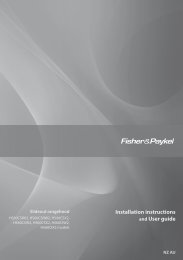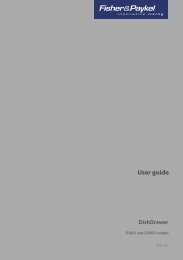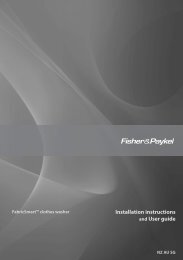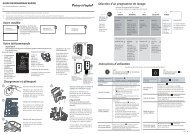Refrigerators & Freezers User Guide Asia 2006 - Fisher & Paykel
Refrigerators & Freezers User Guide Asia 2006 - Fisher & Paykel
Refrigerators & Freezers User Guide Asia 2006 - Fisher & Paykel
Create successful ePaper yourself
Turn your PDF publications into a flip-book with our unique Google optimized e-Paper software.
Refrigerator & Freezer<br />
<strong>User</strong> guide EN<br />
New Zealand Australia USA Canada Europe <strong>Asia</strong> Pacific
Important: This <strong>User</strong> <strong>Guide</strong> is to be used for all refrigerator/freezers. It contains all the<br />
general information required for the operation of your refrigerator/freezer.<br />
A <strong>User</strong> <strong>Guide</strong> is provided with the Ice & Water refrigerator. This booklet contains additional<br />
specific information about the ice and water functions on the refrigerator.<br />
The models shown in this user guide may not be available in all markets and are subject<br />
to change at any time. For current details about model and specification availability in<br />
your country, please go to our website www.fisherpaykel.com or contact your local<br />
<strong>Fisher</strong> & <strong>Paykel</strong> dealer.
Contents<br />
General Operating Instructions – All Products<br />
Important Safety Information 4<br />
Installation - Four Essential Requirements 6<br />
Moving or Storing Your Refrigerator 9<br />
Door Conversion 10<br />
Ice & Water <strong>Refrigerators</strong><br />
Please refer to supplement Ice & Water <strong>User</strong> <strong>Guide</strong> 12<br />
Active Smart® <strong>Refrigerators</strong><br />
Operating Instructions 12<br />
Special Features 14<br />
Maintenance 16<br />
Cleaning Care 17<br />
Cyclic and Compact <strong>Refrigerators</strong><br />
Operating Instructions 21<br />
Special Features and Maintenance 22<br />
Cleaning Care 23<br />
Vertical <strong>Freezers</strong><br />
Operating Instructions 26<br />
Chest <strong>Freezers</strong><br />
Operating Instructions 26<br />
Special Features and Maintenance 27<br />
Food Care – All Products<br />
Storing Food in your Refrigerator 28<br />
Storing Food in your Freezer 30<br />
Problem Solving Checklist 32<br />
Customer Care Information 34<br />
Active Smart® Models<br />
635mm wide E331T, E372B, E381T, E402B, E411T, E415H<br />
680mm wide E406B, E413T, E440T, E442B<br />
790mm wide E521T, E522B<br />
Cyclic and Compact Models<br />
525mm wide P120, E169T, C170T, C190, E240B, E249T, C270<br />
635mm wide C373, C450, E373, E450<br />
Vertical Freezer Models<br />
525mm wide E150, E210<br />
635mm wide E308, E388<br />
Chest Freezer Models<br />
Slimline H215, H275, H320<br />
Standard H160, H220, H280, H360, H510, H701<br />
EN<br />
3
4<br />
Important Safety Information<br />
To reduce the risk of fire, electric shock, or injury to persons read the IMPORTANT SAFETY<br />
INSTRUCTIONS before operating this appliance.<br />
Use this appliance only for its intended purpose as described in this <strong>User</strong> <strong>Guide</strong>.<br />
Warning<br />
When using this appliance always exercise basic safety precautions including the following:<br />
Danger<br />
This appliance is not intended for use by young children or infirm persons without supervision.<br />
Young children should be supervised to ensure they do not play with the appliance.<br />
Risk of child entrapment. Before you throw away your old refrigerator or freezer:<br />
–Take off the doors<br />
–Leave the shelves in place so that children may not easily climb inside.<br />
Disposal<br />
Extreme care must be taken when disposing of your old appliance to avoid hazards. The<br />
refrigerant gas must be safely removed and for the safety of young children, remove doors.<br />
Your <strong>Fisher</strong> & <strong>Paykel</strong> Appliances Authorised Service Centre will be able to give advice on<br />
environmentally friendly methods of disposing of your old refrigerator or freezer.<br />
Electrical<br />
This appliance must be properly installed in accordance with the installation instruction before it<br />
is used.<br />
Never unplug your refrigerator by pulling on the power cord.<br />
Always grip the plug firmly and pull straight out from the outlet.<br />
Do not plug in any other appliance at the same power point as your refrigerator or use extension<br />
cords or double adapters.<br />
Repair or replace immediately all electric service cords that have become frayed or otherwise<br />
damaged. Do not use a cord that shows cracks or abrasion along its length or at either the plug<br />
or appliance end.<br />
If the power supply cord is damaged, it must only be replaced by your <strong>Fisher</strong> & <strong>Paykel</strong> Appliances<br />
Authorised Service Centre because special purpose tools are required.<br />
When moving your appliance away from the wall, be careful not to roll over or damage the<br />
power cord.<br />
Unplug your refrigerator before cleaning or replacing the lightbulb.
Important Safety Information<br />
Storing Food and Drinks<br />
Never store volatile or flammable materials in your refrigerator or freezer as they may explode.<br />
Never freeze liquids in glass containers. Liquid expands during freezing, which may cause the<br />
container to explode.<br />
Never freeze carbonated drinks. They may explode.<br />
Do not consume food if it is too cold. Food removed from the freezer compartment may be cold<br />
enough to cause damage when brought into contact with bare skin e.g. frozen ice cubes.<br />
Power Failure – Food Safety<br />
Do not refreeze frozen foods that have thawed completely. Follow the recommendations below<br />
if you discover food in your freezer has thawed:<br />
1) Ice crystals still visible – food may be refrozen but should be stored for a shorter period than<br />
recommended.<br />
2) Thawed but refrigerator cold – refreezing generally not recommended. Fruits and some<br />
cooked food can be refrozen but use as soon as possible. Meat, fish, poultry – use immediately<br />
or cook then refreeze. Vegetables – discard as they usually go limp and soggy.<br />
3) Thawed but warmer than 4˚C. Red meat can be cooked immediately and refrozen but use as<br />
soon as possible. Discard all other frozen foods.<br />
Do not refreeze frozen foods that have thawed completely. The food may be dangerous<br />
to eat.<br />
Cleaning<br />
Many commercially available cleaning products contain solvents which may attack plastic<br />
components of your refrigerator or freezer and cause them to crack. Please refer to the cleaning<br />
care section of this booklet for further advice.<br />
SAVE THESE INSTRUCTIONS<br />
EN<br />
5
6<br />
Installation - Four Essential Requirements<br />
Please follow the steps for installation to ensure your appliance operates correctly.<br />
1. Power<br />
The appliance must be installed so the plug is accessible.<br />
To ensure that the appliance is not accidentally switched off, connect your refrigerator or freezer<br />
to its own power point. Do not plug in any other appliance at this power point or use extension<br />
cords and double adaptors, as the combined weight of both power cords can pull the double<br />
adaptor from a wall outlet socket.<br />
For power requirements, refer to the information on the serial plate located at the front bottom<br />
right-hand side of the refrigerator when the door is open.<br />
It is essential that the appliance be properly grounded (earthed).<br />
2. Location<br />
Your refrigerator or freezer should not be located in direct sunlight or next to any heat generating<br />
appliance such as a cooktop, oven or dishwasher.<br />
3. Stability<br />
It is important that all four corners of the refrigerator or freezer base are supported firmly on the<br />
floor to eliminate any cabinet movement.<br />
Installing the appliance on a soft or uneven or unlevel floor may result in twisting of the cabinet<br />
and poor sealing of the doors. If the doors do not seal properly, warm air will enter<br />
the food storage areas causing the temperature to increase, resulting in food spoilage and<br />
food loss.<br />
Before moving your refrigerator or freezer into its position, ensure that the adjustable front feet<br />
are fully retracted by turning them anticlockwise, ie. towards the right of the cabinet.<br />
Position your refrigerator or freezer. Turn the adjustable feet clockwise, ie. to the left, to lower<br />
the adjustable front feet. Raise the front of the appliance until it is stable and the doors move<br />
towards the closed position, on their own, when open.<br />
The front levelling foot on the hinge side should take the majority of the weight of the cabinet<br />
and the cabinet should be stable, i.e. cabinet should not rock or wobble.<br />
Raise Lower
Installation - Four Essential Requirements<br />
4. Ventilation and Installation<br />
To ensure adequate ventilation for your refrigerator<br />
or vertical freezer see recommended cabinetry<br />
dimensions below. To ensure adequate ventilation for<br />
chest freezers, allow a minimum of 20mm of airspace<br />
on each side of the cabinet, and 75mm at the rear.<br />
The appliance is intended to be placed against a wall<br />
with a free distance not exceeding 75mm.<br />
If integrating your refrigerator, follow installation<br />
instructions provided with the integration kits.<br />
Flush with refrigerator chassis<br />
– full door rotation<br />
Cabinetry dimensions<br />
(mm) (including<br />
minimum clearances)<br />
P120<br />
C190/E150<br />
Flush with refrigerator door<br />
– 90˚ door rotation<br />
C270/E210<br />
C373<br />
E373/E308<br />
C450<br />
E450/E388<br />
C170T<br />
E169T<br />
E249T<br />
E240B<br />
E331T<br />
Flush with refrigerator door<br />
– full door rotation<br />
E372B<br />
E381T<br />
E415H<br />
E402B<br />
E411T<br />
E406B<br />
E413T<br />
A inside height 869 1257 1645 1525 1745 1257 1645 1475 1645 1745 1645 1745 1745<br />
Flush with refrigerator chassis – full door rotation<br />
B inside width 565 565 565 675 675 565 565 675 675 675 720 720 830<br />
C inside depth 502 502 502 620 620 502 502 620 620 620 620 620 620<br />
Flush with refrigerator door – 90º door rotation<br />
D inside width 565 565 565 675 680 565 565 680 680 680 725 725 835<br />
E inside depth flush to<br />
curved door<br />
552 552 552 670 670 552 552 675 675 675 675 675 675<br />
F inside depth flush to<br />
flat door<br />
n/a n/a n/a n/a 690 n/a n/a n/a n/a 690 n/a 690 690<br />
Flush with refrigerator door – full door rotation<br />
G inside width 685 685 685 795 795 685 685 795 795 795 840 840 950<br />
H inside depth flush to<br />
curved door<br />
552 552 552 670 670 552 552 675 675 675 675 675 675<br />
I inside depth flush to<br />
flat door<br />
Minimum clearances<br />
n/a n/a n/a n/a 690 n/a n/a n/a n/a 690 n/a 690 690<br />
J side clearance<br />
K side clearance – hinge<br />
20 20 20 20 20 20 20 20 20 20 20 20 20<br />
side flush with door<br />
– 90° rotation<br />
L side clearance – hinge<br />
25 25 25 25 25 25 25 25 25 25 25 25 25<br />
side flush with door<br />
– full rotation<br />
140 140 140 140 140 140 140 140 140 140 140 140 140<br />
M rear clearance<br />
(incl. evaporator tray)<br />
30 30 30 30 30 30 30 30 30 30 30 30 30<br />
N vent 50 50 50 50 50 50 50 50 50 50 50 50 50<br />
E440T<br />
E442B<br />
E521T<br />
E522B<br />
EN<br />
7
8<br />
Installation - Four Essential Requirements<br />
Before Placing Food in the Fresh Food or Freezer Compartments<br />
Remove all packaging. Ensure that all transit clips are removed from the refrigerator. These are<br />
small rubber stops located at the back of the shelves.<br />
Allow the refrigerator and freezer to run empty for 2–3 hours to allow each compartment to cool<br />
to the appropriate temperature.<br />
Clean the inside of the appliance with warm water and a little liquid detergent to remove<br />
manufacturing and transportation dust.<br />
The appliance may have an odour on its initial operation, but this will go when the refrigerator<br />
and freezer have cooled sufficiently.<br />
Energy Efficiency<br />
Do not cover your appliances with any material that will prevent air from flowing around the<br />
cabinet sides.<br />
Do not leave the door open for any longer than is necessary.<br />
Allow good clearances in front of the air ducts within the cabinet for maximum cold air<br />
distribution.
Moving or Storing Your Refrigerator<br />
If your refrigerator or freezer is turned off for any reason, wait 10 minutes before turning it back<br />
on. This will allow the refrigeration system pressures to equalise before restarting.<br />
Moving Your Refrigerator<br />
Turn off the appliance and unplug from the power point. Remove all food.<br />
Turn the adjustable feet to the right as far as they will turn (see page 6).<br />
Ease the refrigerator out of its position. Tuck the power cord away and tape the doors closed.<br />
Tape the shelves in place. If the cabinet needs to be placed at an angle or laid down, carefully lay<br />
it on its side (the right hand side when viewed from the front).<br />
Relocate and install. If the appliance has been left on its side for any length of time, leave it<br />
standing upright for at least 10 minutes before turning on.<br />
Storing Your Refrigerator or Freezer<br />
When storing your cleaned appliance, leave the door(s) open. This allows air to circulate and<br />
prevents the build up of bacteria and moulds.<br />
Before using again, clean well using a mixture of warm water and baking soda (add 1 teaspoon<br />
of baking soda to each 500 ml of water). Rinse with clean water.<br />
Holiday Time<br />
We recommend you leave your refrigerator or freezer operating while you are on holiday.<br />
EN<br />
9
10<br />
Door Conversion<br />
If you need to hinge your door on the opposite side we<br />
recommend that you call your local <strong>Fisher</strong> and <strong>Paykel</strong> Authorised<br />
Service Centre or Dealer to make this conversion.<br />
Active Smart® refrigerators with silver handles need to be ordered<br />
either with left or right opening doors and can not be interchanged.<br />
All other models except those models listed below need to have an<br />
appropriate conversion kit for your model refrigerator.<br />
The kit is available from your Authorised Service Centre or Dealer.<br />
Full instructions are included in the conversion kit.<br />
If you have the following compact model refrigerators you can<br />
change the door by following these instructions:<br />
P120, C190, C270, E150, E210<br />
Switch off the appliance and remove all the food stuffs and shelves<br />
from the doors.<br />
Remove the hinge cover from the top of the cabinet. This is<br />
achieved by levering it up carefully from the front.<br />
Remove the top hinge bracket screws using a ‘Philips’ screwdriver<br />
and remove the top hinge bracket, ensuring that the door is held<br />
firmly. (Refer Figure 1).<br />
Open the door and lift it off.<br />
Insert the plastic hinge plugs supplied with the installation kit into<br />
the removed top hinge bracket holes. Remove the existing plastic<br />
hinge plugs from the opposite side.<br />
Tilt the refrigerator back, either right onto its back or lean it against<br />
a wall, and unscrew both adjustable feet.<br />
Remove the plastic bottom hinge bracket bolt holding the bottom<br />
hinge bracket to the underside of the cabinet. Replace the bottom<br />
hinge bracket bolt without the bottom hinge bracket.<br />
Remove existing cap door closing from bottom hinge bracket.<br />
On the opposite side remove the bottom hinge bracket bolt and fit<br />
the bottom hinge bracket.<br />
Note: that it is rotated so that it is a mirror image of itself on the<br />
other side (refer Figure 2).<br />
Replace the adjustable feet turning them as far as they will go.<br />
Carefully stand the refrigerator upright again.<br />
Figure 1<br />
Figure 2
Door Conversion<br />
Fit new cap door closing to bottom hinge bracket. The new<br />
cap door closing is a mirror image of the existing part.<br />
Remove the hinge hole covers from the ends of the door<br />
using a narrow blade to prise them away from the door. The<br />
hinge hole covers are the components without holes. Keep<br />
them for re-use.<br />
Move the hinge bearing on the door to the opposite side of<br />
the top of the door (refer Figure 3).<br />
Fit the new hinge bearing closing hook to the opposite side<br />
of the bottom door. The new hinge bearing hook is a mirror<br />
image of the existing part.<br />
Remove the old hinge bearing closing hook from the door<br />
(refer Figure 4).<br />
Replace the door. Replace the top hinge bracket and secure<br />
with the top hinge bracket screws making sure that the door<br />
is square.<br />
Hinge Cover<br />
Hinge Bearing<br />
Closing Hook<br />
Bottom Hinge<br />
Bolt<br />
Top Hinge<br />
Bracket<br />
Figure 3<br />
Figure 4<br />
Hinge Bearing<br />
Hinge Hole<br />
Cover<br />
Cap Door Closing Bottom Hinge<br />
Bracket<br />
EN<br />
11
12<br />
Active Smart® Operating Instructions<br />
Models: 635mm wide E331T, E372B, E381T, E402B, E411T, E415H<br />
680mm wide E406B, E413T, E440T, E442B<br />
790mm wide E521T, E522B<br />
For information on the operation of the Ice & Water control panel please refer to<br />
the Ice & Water <strong>User</strong> <strong>Guide</strong>.<br />
Temperature Control<br />
When the refrigerator is first turned on, the powerful cooling system will automatically cool both<br />
refrigerator and freezer compartments to their set temperatures. This will take between 2-3 hours<br />
depending on the temperature and humidity of the environment.<br />
The two compartment temperatures are accurately and independently controlled and do not<br />
change with the temperature or humidity of the surroundings; whether summer or winter.<br />
If you wish to alter the temperature of either the fresh food compartment or freezer<br />
compartment, this can be easily done by using the control panel located at the back of the fresh<br />
food compartment.<br />
Control Panel To adjust temperatures<br />
Fresh food and freezer<br />
compartment indicator<br />
Compartment<br />
select button<br />
Increase temperature button<br />
Decrease temperature button<br />
Temperature<br />
indicator (thermometer)<br />
Fresh Food Compartment<br />
The fresh food compartment light on the refrigerator diagram will be showing. The temperature<br />
indicator illustrated by a thermometer will show the temperature setting for this compartment as<br />
a series of lights.<br />
The temperature may be altered by pressing the increase temperature or decrease temperature<br />
buttons. One press on either of these buttons will produce a dimmer light which indicates a<br />
small change in temperature.<br />
Pressing either button twice gives a brighter light and indicates a greater change in temperature.<br />
Fewer lights on the thermometer means a cooler temperature for the compartment selected.<br />
Freezer Food Compartment<br />
To adjust the freezer temperature press the compartment select button until the light flashes on<br />
the freezer compartment indicator.<br />
The freezer temperature can be altered by pressing the increase or decrease temperature buttons.<br />
One press on either of these buttons will produce a dimmer light which indicates a small change<br />
in temperature. Pressing either button twice gives a brighter light and indicates a greater change<br />
in temperature.<br />
Note: Successively pressing the compartment select button will automatically select between the<br />
compartments, a return to the fresh food compartment will be accompanied by a longer beep.<br />
When the door is reopened the control panel will return automatically to the fresh food<br />
compartment setting.
Active Smart® Operating Instructions<br />
Sabbath Mode<br />
To activate the Sabbath mode press the compartment select button on the temperature control<br />
panel for 10 seconds.<br />
When the Product is in Sabbath Mode:<br />
The light will not operate when the door is opened.<br />
The door alarm will not operate.<br />
The display will not be illuminated.<br />
Opening the door will not affect the compressor or fans.<br />
If the power to the refrigerator is turned off whilst in this mode, the product will continue in<br />
Sabbath mode when the power is restored.<br />
Sabbath mode will automatically de-activate 80 hours after activation.<br />
To de-activate earlier than 80 hours press the compartment select button on the temperature<br />
control panel for 10 seconds.<br />
Normal Refrigerator Sounds<br />
Active Smart® refrigerators, with their excellent energy ratings and cooling performance, can<br />
produce sounds somewhat different to your old refrigerator.<br />
Normal Operational Sounds Include:<br />
Fan air flow sound. Active Smart® refrigerators have fans which change speed depending on<br />
demand. During cooling periods, such as after frequent door openings, fans circulate the cold<br />
air in the refrigerator and freezer compartments producing some air flow sound. This is quite<br />
normal.<br />
Cracking or popping which may sound like ice coming off the evaporator. This occurs when the<br />
defrost function is operating.<br />
Running water sound. This is the liquid refrigerant in the system and can be heard as a boiling or<br />
gurgling noise.<br />
An audible hissing sound after closing the freezer door. This is due to the pressure difference<br />
between the warm air that has entered the cabinet and suddenly cooled, and the outside air<br />
pressure.<br />
Other strange sounds may be heard for the following reasons:<br />
– Cabinet not level<br />
– Floor uneven or weak<br />
– Bottles or jars rattling on shelves<br />
EN<br />
13
14<br />
Active Smart® Special Features<br />
Fruit and Vegetable Bins and Humidity Control Cover<br />
The fruit and vegetable bins feature a unique cover which provides two functions:<br />
The humidity cover seals the bins and provides a humid microclimate to extend storage times of<br />
fruits and vegetables.<br />
The humidity cover prevents condensation, which forms at high humidities, from dripping down<br />
onto the fruit and vegetables. The ability to retain high humidity in the fruit and vegetable bin<br />
may produce small amounts of water in the bottom of the fruit and vegetable bins. This can be<br />
wiped out as required.<br />
Fruit and Vegetable Bins and Humidity Slide<br />
Each fruit and vegetable bin has a humidity adaptor control that can be adjusted to fruit or<br />
vegetables depending on what is stored in the bins.<br />
If possible try to store fruit and vegetables separately. This will help extend their storage life.<br />
If there is a mixture of fruit and vegetables in the bin adjust the position of the control to the centre.<br />
If there is too much water in the bins the control can be adjusted towards the setting with fewer drips.<br />
Remember a small amount of water in the bins is beneficial for fruit and vegetable storage.<br />
SUITABLE FOR:<br />
Salad Greens<br />
Lettuce<br />
Spinach<br />
Broccoli<br />
Cabbage<br />
Carrots<br />
Mixed fruit<br />
& vegetables<br />
Fruit with<br />
skin/peel<br />
Oranges<br />
Lemons<br />
Limes<br />
Ice Trays and Lid<br />
To empty the ice cubes into the lid, hold the tray and lid together and twist to dislodge.<br />
Refill the ice tray with water, place lid containing ice cubes on top and store in the freezer.<br />
Ice cubes are best stored in a closed container or plastic bag as they readily absorb odours and<br />
tastes from other foods.<br />
Deodoriser (Where Fitted)<br />
A deodoriser is fitted to remove unpleasant odours from the refrigerator. It is located behind the<br />
duct cover in the fresh food compartment and will last for the life of your fridge.<br />
Door Alarms<br />
If the fresh food compartment door is left open the alarm will beep after 90 seconds and if the<br />
freezer door is left open the alarm will beep after 60 seconds.<br />
While either door remains open, subsequent beeps will sound every 30 seconds for 5 minutes.<br />
A continuous alarm will sound if the door has been left open for 5 minutes or longer and the light<br />
will turn off. The alarm will stop when the door is closed.
Active Smart® Special Features<br />
Fault Alarms<br />
If the electronic controller detects a fault from which it is unable to recover an alarm will sound.<br />
When the fresh food compartment door is opened a fault code (specific pattern of lights) will<br />
flash red and green on the Control panel to alert you to the fault. The audible alarm will stop<br />
when any button is pressed but the lights will remain flashing. If such a fault occurs, call your<br />
<strong>Fisher</strong> & <strong>Paykel</strong> Appliances Authorised Service Centre immediately; the fault code will help the<br />
service person find and remedy the cause of failure.<br />
Divider Instructions<br />
To fit the divider, insert divider into bin on an angle, straighten and slot into place. To adjust the<br />
divider, fully extend the bin, partially lift the divider, slide sideways and re-slot into position.<br />
Roll Out Drawer Model E415H<br />
The roll out drawer is suitable for storing fruits and vegetables as well as tall bottles and drinks.<br />
A vent/baffle is located at the front of the drawer.<br />
The temperature in the drawer can be adjusted by opening or closing this vent.<br />
Opening the vent fully allows more cold air into the drawer. Typical operating temperatures in<br />
this compartment are from 3˚C to 9˚C.<br />
The closed vent situation is ideal for storage of tomatoes, tropical fruit, cucumber, capsicum etc.<br />
as these foods do not keep as well at colder temperatures.<br />
The open vent situation is suitable for most vegetables and fruits. Uncut fruit and vegetables<br />
with protective skin (eg. apples and pears) can be stored without wrapping.<br />
To extend the storage life of other fruit and vegetables place them in loosely sealed plastic bags.<br />
This will reduce moisture loss and prevent excess moisture build-up.<br />
Bottle Rack (Where Fitted)<br />
The bottle rack can be used to store a variety of bottles and can be positioned anywhere you<br />
would a shelf. To re-position, lift the rear of the rack and pull forward. Bottles are best stored with<br />
the top facing the front of the refrigerator.<br />
EN<br />
15
16<br />
Active Smart® Maintenance<br />
Replacement of the Interior Light (Halogen Light Bulb)<br />
Turn the power off at the wall socket before replacing the bulb. The light bulb is located on the<br />
top roof of the cabinet at the front.<br />
Remove the lens cover using a small screwdriver. Insert the screwdriver in the front centre of the<br />
lens cover and gently lever down. Pull out old bulb.<br />
Do not touch the new bulb with your hand. Leave it in the plastic bag whilst slotting into position.<br />
Remove plastic bag when bulb is in position.<br />
Replace lens cover.<br />
Turn power on. Light bulb should now glow.<br />
Note: The replacement halogen bulb must not exceed 12 Volt/10 Watt. Bulbs are available<br />
from your <strong>Fisher</strong> & <strong>Paykel</strong> Appliances Customer Care Centre.<br />
Your refrigerator is designed to operate for many years without the need for service checks.<br />
However, if your refrigerator is malfunctioning, have it attended to by your <strong>Fisher</strong> & <strong>Paykel</strong><br />
Appliances Authorised Service Centre as soon as possible. All electrical repairs must be<br />
carried out by an adequately trained service technician or qualified electrician.
Active Smart® Cleaning Care – Interior/Exterior<br />
Interior<br />
It is important to keep the interior of the refrigerator and freezer clean to help prevent food from<br />
becoming contaminated during storage.<br />
The amount and types of food stored determines how often cleaning should be carried out<br />
(ideally once every 1 to 2 weeks) in the refrigerator.<br />
Remove the shelves from cabinet and door. Wash shelves and storage bins in warm water and<br />
detergent; rinse in clean water and dry before replacing.<br />
Wipe over the interior surfaces with warm water and detergent or baking soda dissolved in warm<br />
water (add 1 teaspoon of baking soda to each 500mls of water). Rinse with clean water.<br />
To help remove “old stale refrigerator” smells add a few drops of vanilla essence or vinegar to the<br />
water before cleaning.<br />
Clean exterior surfaces with warm water and detergent. Use a toothbrush for the magnetic<br />
door gasket.<br />
Do not use harsh, abrasive cloths or cleaners or highly perfumed, strong smelling cleaners or<br />
solvents on any part of the refrigerator or freezer.<br />
Exterior<br />
Stainless Exterior Door<br />
It is important when cleaning the exterior door surface of your refrigerator, to only use liquid<br />
dishwashing detergent dissolved in warm water.<br />
Dry the door with a clean, lint free cloth.<br />
The use of any abrasive or stainless steel cleaners and solvents will damage the door surface.<br />
Other Exterior Surfaces<br />
Clean all other exterior surfaces with warm water and detergent.<br />
If necessary, clean the magnetic door gasket with an old toothbrush, warm water and detergent.<br />
EN<br />
17
18<br />
Active Smart® Cleaning Care – Special Features<br />
Interior<br />
Glass Shelves<br />
Clean with warm water and detergent or a glass cleaner. If cleaning the shelves without<br />
removing from the cabinet, use only warm water and detergent as a glass cleaner can damage<br />
the plastic components of your refrigerator.<br />
Bottle Rack (Where Fitted)<br />
Clean with warm water and detergent. The use of abrasive cleaners and solvents may cause<br />
damage.<br />
To Remove Trays or Fixed Bins<br />
For ease of removal, empty food from tray/bin first.<br />
Hold the centre front of the tray/bin handle.<br />
Lift vertically to unclip from the runners and pull tray/bin towards you to remove.<br />
Push runners back into refrigerator.<br />
To Replace Trays or Fixed Bins:<br />
With the runners pushed back into the refrigerator, place the tray/bin on top of the runners.<br />
Push the tray/bin back slowly until you feel it clip back onto the runners.<br />
Important Note: Ensure that trays and bins are securely clipped onto the runners before use.<br />
Important Notice<br />
Bin and tray runners are pre-lubricated, and will not need to be re-lubricated during their<br />
life. Do not attempt to clean grease from the runners, as this will affect their ability to<br />
function. Do not immerse runners in water.
Active Smart® Cleaning Care – Special Features<br />
Humidity Control System<br />
Important Note: When cleaning the shelf above<br />
the vegetable bins, we recommend that you do<br />
not disassemble the Humidity Control System<br />
from the shelf.<br />
In the event that the plastic lid and humidity slides<br />
become separated from the glass shelf, follow these<br />
instructions to reassemble.<br />
1 Turn shelf upside down<br />
2 To attach humidity slides onto shelf<br />
front corners, fit bottom clips into shelf<br />
front trim. Next, slide sideways towards<br />
shelf until arm clips onto glass.<br />
3 To attach humidity control lid – with<br />
text facing you, align lid with front of<br />
shelf. Hold lid vertically and fit front<br />
end into retainer on shelf. Ensure lid<br />
fits into retainer as well as underneath<br />
humidity slides.<br />
4 At the sides of the shelf, adjust<br />
humidity slide tabs so that the plastic<br />
lid is between the shelf and the tabs.<br />
5 If clips on back of shelf are present,<br />
fasten lid with rear clips. Ensure that<br />
the cover is fully secure at front and<br />
back of shelf.<br />
Retainer<br />
Humidity Slides<br />
EN<br />
19
20<br />
Active Smart® Cleaning Care – Special Features<br />
Roll Out Fruit and Vegetable Bin – E415H<br />
Remove for cleaning by pulling out the compartment until it stops, lifting and then continuing<br />
to slide it forward until it is fully extended.<br />
Rest the door front on the floor and with the refrigerator compartment door open, remove the<br />
tray, divider rack and bin. Wash with warm water and detergent.<br />
Rinse, dry and replace.<br />
Lower Shelf in Models With Roll Out Fruit and<br />
Vegetable Bin – E415H<br />
Remove the front baffle after lifting its inner edge. With the<br />
refrigerator compartment door open, slide the shelf forward and<br />
lift out. Clean with warm water and detergent.<br />
Rinse, dry and replace in the second groove up from the side<br />
runner rail.<br />
Important Note: Many commercially available cleaning products contain solvents that may<br />
attack the plastic components of your freezer and cause them to crack. It is important to<br />
use only warm water and a small amount of liquid dishwashing detergent on any plastic<br />
components inside and outside your freezer. Avoid using anti-bacterial cleaning products on<br />
either the interior or exterior of the cabinet as they may cause rusting of metal components<br />
and cracking of plastic components.
Cyclic and Compact Operating Instructions<br />
Models: 525mm wide P120, E169T, C170T, C190, E240B, E249T, C270<br />
635mm wide C373, E373, C450, E450<br />
Temperature Control<br />
The control has been factory set for normal operating conditions.<br />
Allow the refrigerator to run empty for 2-3 hours before placing food inside the fresh food or<br />
freezer compartments.<br />
Re-adjust the control as necessary to suit your individual preference.<br />
1 is warmest<br />
7 is coldest<br />
We recommend adjusting the temperature by half a setting initially and then allow at least 24<br />
hours for the cabinet temperature to stabilise before readjusting.<br />
If you are altering the temperature of a 2-door refrigerator, remember you are altering the<br />
temperature of both compartments.<br />
The running time and temperature are affected by where your refrigerator is located, how<br />
often the door is opened and the temperature of the room the refrigerator is located in. Your<br />
refrigerator is designed to operate in a room temperature of between 10°C and 43°C.<br />
EN<br />
21
22<br />
Cyclic and Compact<br />
Special Features and Maintenance<br />
P120 Ice Box<br />
This is designed for short-term storage of frozen foods and ice only. It is recommended that<br />
the tray is kept in place under the ice box at all times.<br />
Door Alarms (E169T, E240B, E249T, E373, E450 Only)<br />
If the fresh food compartment door is left open the alarm will beep after 90 seconds.<br />
If the door remains open, subsequent beeps will sound every 30 seconds for 5 minutes.<br />
A continuous alarm will sound if the door has been left open for 5 minutes or longer.<br />
The alarm will stop when the door is closed.<br />
Fault Alarms<br />
If the electronic controller detects a fault from which it is unable to recover, an alarm will sound<br />
when the door is opened.<br />
When the fresh food compartment door is opened and a fault has occurred, a specific number of<br />
beeps will sound. If a fault occurs, call your <strong>Fisher</strong> & <strong>Paykel</strong> Authorised Service Centre immediately;<br />
the number of beeps will help the service person find and remedy the cause of failure.<br />
Humidity Control Cover (635mm Wide Models)<br />
The vegetable bins feature a unique cover which provides two functions:<br />
The humidity control cover seals the bins to provide a humid microclimate to extend storage times.<br />
The humidity control cover prevents condensation which forms at high humidities from dripping<br />
down onto the fruit and vegetables.<br />
The ability to retain high humidity in the fruit and vegetable bin may produce small amounts of<br />
water in the bottom of the fruit and vegetable bin. This can be wiped out as required.<br />
Replacement of Interior Light<br />
Turn the power off at the wall before replacing the lamp. The<br />
interior lamp is located at the back of the temperature control<br />
box and is removed by unscrewing it.<br />
Replace bulb, making sure it is tightly screwed in. Switch power<br />
back on again.<br />
The replacement bulb must not exceed 230 Volt/15 Watt. Bulbs<br />
are available from your <strong>Fisher</strong> & <strong>Paykel</strong> Authorised Service Centre.<br />
4<br />
1<br />
Unscrew bulb from<br />
rear of control box<br />
Important Note: Your refrigerator is designed to operate for many years without the need<br />
for frequent service checks. However, if your refrigerator is malfunctioning, have it attended<br />
to by your <strong>Fisher</strong> & <strong>Paykel</strong> Authorised Service Centre as soon as possible.<br />
All electrical repairs must be carried out by an adequately trained service technician or<br />
qualified electrican.
Cyclic & Compact Cleaning Care – Interior/Exterior<br />
Interior<br />
It is important to keep the interior of the refrigerator and freezer clean to help prevent food from<br />
becoming contaminated during storage.<br />
The amount and types of food stored determines how often cleaning should be carried out<br />
(ideally once every 1 to 2 weeks) in the refrigerator.<br />
Remove the shelves from cabinet and door. Wash shelves and storage bins in warm water and<br />
detergent; rinse in clean water and dry before replacing.<br />
Wipe over the interior surfaces with warm water and detergent or baking soda dissolved in warm<br />
water (add 1 teaspoon of baking soda to each 500mls of water). Rinse with clean water.<br />
To help remove “old stale refrigerator” smells add a few drops of vanilla essence or vinegar to the<br />
water before cleaning.<br />
Clean exterior surfaces with warm water and detergent. Use a toothbrush for the magnetic<br />
door gasket.<br />
Do not use harsh, abrasive cloths or cleaners or highly perfumed, strong smelling cleaners or<br />
solvents on any part of the refrigerator or freezer.<br />
Glass Shelves<br />
Clean with warm water and detergent or a glass cleaner. If cleaning the shelves without<br />
removing from the cabinet use only warm water and detergent as a glass cleaner can damage<br />
the plastic components of your refrigerator.<br />
Exterior<br />
Stainless Exterior Door<br />
It is important when cleaning the exterior door surface of your refrigerator, to only use liquid<br />
dishwashing detergent dissolved in warm water.<br />
Dry the door with a clean, lint free cloth.<br />
The use of any abrasive or stainless steel cleaners and solvents will damage the door surface.<br />
Other Exterior Surfaces<br />
Clean all other exterior surfaces with warm water and detergent.<br />
If necessary, clean the magnetic door gasket with an old toothbrush, warm water and detergent.<br />
Water Evaporator Tray<br />
The water evaporator tray is found above the compressor at the back of the refrigerator or<br />
freezer. The tray may require infrequent cleaning.<br />
Carefully move the refrigerator or freezer out from the wall. Switch off the appliance.<br />
If the tray is full, have one person support the tray while another person unscrews the fasteners.<br />
Take care not to spill any liquid over the electrical components. Empty trays may have the<br />
fasteners loosened and the tray slipped over through the keyhole. (Reverse order to reassemble).<br />
Wipe out with warm water and detergent or disinfectant.<br />
Reassemble taking care not to over-tighten the fasteners. Switch on the appliance.<br />
EN<br />
23
24<br />
Cyclic and Compact Cleaning Care<br />
Special Features<br />
Vegetable Bin – 525mm Wide Models<br />
– Except P120 Models<br />
Wash in warm water and detergent. Rinse and dry.<br />
Fruit and Vegetable Bins and Cover<br />
– 635mm Wide Models<br />
Remove bins then the bottom refrigerator shelf.<br />
Place the shelf upside down on a flat surface. Pull cover at<br />
position A then lift up at position B. Take cover off at sides.<br />
Clean cover and bins in warm soapy water.<br />
To reassemble, insert cover and clip at position C, then snap in<br />
the clip at position A.<br />
B<br />
A<br />
Humidity<br />
Control Cover<br />
C<br />
Shelf
Cyclic and Compact Cleaning Care<br />
Defrosting Model C170T<br />
It is recommended that a freezer be defrosted when the frost is greater than 6mm thick.<br />
Remove all frozen food and wrap it in several layers of paper. Place food in the refrigerator<br />
compartment or a cool environment e.g. insulated picnic bin.<br />
Switch the power off at the wall. The temperature control can remain at its normal setting.<br />
Remove the freezer baskets or shelves for ease of cleaning.<br />
Whilst defrosting, leave the freezer door open. If you wish to reduce the defrosting time place a<br />
bowl of warm water in the freezer compartment and leave the door open. Keep the refrigerator<br />
compartment door closed.<br />
Use the scraper supplied or a plastic spatula to remove any loose ice. Do not use knives or<br />
any other sharp instrument to remove the ice, otherwise the freezer surface may become<br />
permanently damaged.<br />
Ensure that the defrosting of your freezer is carried out as quickly as possible. During defrosting<br />
a rise in temperature of frozen food above normal storage temperature can shorten the storage<br />
time of the food.<br />
Wipe the freezer dry. Replace the frozen food.<br />
Switch the refrigerator on.<br />
Defrosting Models With Ice Boxes<br />
The P120 is designed for short-term storage of frozen foods and ice only.<br />
Remove all frozen food and wrap it in several layers of paper. Place in a cool environment e.g.<br />
insulated picnic bin.<br />
Position the tray provided beneath the icebox to collect the melting ice.<br />
Push the defrost button in the centre of the control knob. The defrost time may be reduced by<br />
placing a bowl of warm water in the icebox and leaving the door of the refrigerator open.<br />
Use the scraper supplied or a plastic spatula to remove any loose ice.<br />
Immediately after the refrigerator has automatically restarted, empty the tray of water and ice.<br />
Wipe the tray and icebox dry.<br />
Replace the frozen food.<br />
EN<br />
25
26<br />
Vertical Freezer Operating Instructions<br />
Models: 525mm wide E150, E210<br />
635mm wide E308, E388<br />
Temperature Control<br />
The cabinet control is located at the bottom rear of the cabinet.<br />
The control has been factory set to position 4 for normal<br />
operating conditions.<br />
The freezer temperature should be approximately -18°C.<br />
Re-adjust the control as necessary to suit your individual<br />
preference.<br />
1 is the warmest.<br />
7 is the coldest.<br />
Door Alarms<br />
If the door is left open the alarm will beep after 60 seconds.<br />
If the door remains open, subsequent beeps will sound every 30 seconds for 5 minutes.<br />
A continuous alarm will sound if the door has been left open for 5 minutes or longer.<br />
The alarm will stop when the door is closed.<br />
Fault Alarms<br />
If the electronic controller detects a fault from which it is unable to recover, an alarm will sound<br />
when the door is opened.<br />
When the door is opened and a fault has occurred, a specific number of beeps will sound. If<br />
a fault occurs, call your <strong>Fisher</strong> & <strong>Paykel</strong> Authorised Service Centre immediately; the number of<br />
beeps will help the service person find and remedy the cause of failure.<br />
Chest Freezer Operating Instructions<br />
Temperature Control<br />
The temperature of the freezer is controlled by a thermostat fitted near<br />
the right hand rear corner of the freezer.<br />
The thermostat has been set to position 4 at manufacturing for normal<br />
operating conditions and should not need adjustment.<br />
The freezer compartment should be approximately -18˚C. At this<br />
temperature the food will keep for the length specified on the freezer<br />
storage guide.<br />
Re-adjust the control as necessary to suit your individual preference.<br />
1 is the warmest.<br />
7 is the coldest.<br />
1<br />
2<br />
3<br />
4<br />
5
Chest <strong>Freezers</strong><br />
Special Features and Maintenance<br />
Defrosting Your Chest Freezer<br />
It is recommended that your freezer be defrosted when the frost is greater than 6 to 10mm thick<br />
using the plastic scraper provided.<br />
Remove all frozen food and wrap it in several layers of paper. Place in a refrigerator compartment<br />
or a cool environment e.g insulated bin.<br />
Switch the power off at the wall.<br />
Unplug and open the defrost water drain and spout. Place a shallow container under the spout.<br />
Pour approximately 1 litre of warm water down the drain to clear it of possible residual ice.<br />
Should it remain blocked, the spout can be removed to aid thorough cleaning.<br />
While defrosting, leave the freezer lid open. If you wish to reduce the defrosting time, place<br />
containers of hot water in the freezer and close the lid. Use the scraper supplied and a plastic<br />
spatula to remove any loose ice.<br />
Empty out the tray of water. Wipe out the defrosted freezer. Use a mix of 500ml water with<br />
1 teaspoon of baking soda or a small amount of liquid dishwashing detergent and warm water.<br />
Rinse with clean water and dry.<br />
Carefully clean the drain and spout. Replace the drain plug and then close the spout.<br />
Switch the freezer on. Close the lid and leave running for 15 minutes before replacing the frozen food.<br />
Do not use knives or any other sharp instrument to remove the ice as the freezer surface may<br />
become irreversibly damaged.<br />
Also do not use harsh abrasive cloths and cleaners, or highly perfumed strong smelling cleaners<br />
or solvents on either the interior or exterior of the freezer.<br />
Frost forms faster on the top edge of the freezer compartment in climates of high humidity as<br />
this is the area of first contact to the warm moist air when the lid is open.<br />
Your chest freezer is designed with a flexible lid seal to keep warm air out of the freezer.<br />
Sometimes immediately after closing your chest freezer, you may notice the lid is difficult to<br />
re-open. This is normal. Wait a few minutes and try again.<br />
Freezer Baskets<br />
The baskets supplied with your freezer are removable.<br />
They may be stacked on top of each other by folding the handles downwards. Ensure that<br />
packages do not protrude above the top of each basket, and for ease of lifting make sure they<br />
are not loaded with a lot of heavy food.<br />
We recommend that foods requiring longer storage should be kept at the bottom of the freezer.<br />
Replacement of Interior Light<br />
When it is necessary to replace the light bulb, turn the freezer off at the wall, remove the light<br />
cover and unscrew the bulb. Replace with a new bulb, noting that is must not exceed 15 Watts.<br />
Important Note: Your refrigerator is designed to operate for many years without the need<br />
for frequent service checks. However, if your refrigerator is malfunctioning, have it attended<br />
to by your <strong>Fisher</strong> & <strong>Paykel</strong> Authorised Service Centre as soon as possible.<br />
All electrical repairs must be carried out by an adequately trained service technician or<br />
qualified electrican.<br />
EN<br />
27
28<br />
Storing Food in Your Refrigerator<br />
Storing fresh, perishable foods in your refrigerator helps to extend storage times. The cold<br />
temperatures slow down the major causes of food spoilage – namely, the growth of bacteria,<br />
moulds and yeasts, and chemical and physical reactions.<br />
Fresh Food Care<br />
The quality of food before it is placed in the refrigerator is critical to successful storage. For<br />
best results:<br />
Select foods that are very fresh and of good quality.<br />
Buy only the amount that you will use within the recommended storage time. If you buy extra,<br />
plan to freeze it.<br />
Ensure that food is well wrapped or covered before it is stored. This will prevent food from<br />
dehydrating, deteriorating in colour or losing taste and will help maintain freshness. It will also<br />
prevent odour transfer. Vegetables and fruit need not be wrapped provided they are stored in<br />
the vegetable bins of the refrigerator.<br />
Make sure that strong smelling foods are wrapped or covered and stored away from foods such<br />
as butter, milk and cream which can be tainted by strong odours.<br />
Refrigerate fresh, perishable foods as soon as possible after purchase. If left at room temperature<br />
for any length of time the rate of deterioration will be accelerated.<br />
Avoid placing food directly in front of air outlets, as it may freeze. Cold air needs to circulate to<br />
maintain safe food storage. Do not open the refrigerator door unnecessarily.<br />
Cool hot foods down before placing them in the refrigerator. This should be done quickly. It can<br />
be aided by placing the container of food in a bowl of ice and water; renew the ice as necessary.<br />
(Note also that hot containers may damage shelves and wall of the refrigerator).<br />
Store raw and cooked food in separate containers or packaging to prevent cross contamination.<br />
In addition:<br />
Keep the refrigerator clean. Wipe the inside walls and shelves frequently (refer to Cleaning Care)<br />
and place only clean containers in the refrigerator.<br />
Keep a close check on the quality of food in your refrigerator. Discard any food that shows<br />
signs of spoilage. Pay particular attention to meat, fish and poultry, as these foods are highly<br />
perishable. Use food within the recommended storage times.<br />
Dairy Foods and Eggs<br />
Most pre-packed dairy foods have a recommended use by/best<br />
before/best by’ date stamped on them. Store them in the<br />
refrigerator and use within the recommended time.<br />
Butter can become tainted by strong smelling foods so it is best<br />
stored in a sealed container.<br />
Eggs should be stored in the refrigerator. For best results, especially<br />
when baking, remove the eggs from the refrigerator two hours<br />
before they are to be used.
Storing Food in Your Refrigerator<br />
Red Meat<br />
Place fresh red meat on a plate and loosely cover with waxed paper or<br />
plastic wrap or foil.<br />
Store cooked and raw meat on separate plates. This will prevent any<br />
juices lost from the raw meat from contaminating the cooked product.<br />
Delicatessan meats should be used within the recommended storage time.<br />
Poultry<br />
Fresh whole birds should be rinsed inside and out with cold running<br />
water. Dry and place on a plate. Cover loosely with plastic wrap or foil.<br />
Poultry pieces should also be stored this way. Whole poultry should<br />
never be stuffed until just before cooking, otherwise food poisoning<br />
may result.<br />
Cool and refrigerate cooked poultry quickly. Remove stuffing from<br />
poultry and store separately.<br />
Fish and Seafood<br />
Whole fish and fillets should be used on the day of purchase. Until<br />
required, refrigerate on a plate loosely covered with plastic wrap, waxed<br />
paper or foil.<br />
If storing overnight or longer, take particular care to select very fresh<br />
fish. Whole fish should be rinsed in cold water to remove loose scales<br />
and dirt and then patted dry with paper towels. Place whole fish or<br />
fillets in a sealed plastic bag.<br />
Keep shellfish chilled at all times. Use within 1 – 2 days.<br />
Precooked Foods and Leftovers<br />
These should be stored in suitable covered containers so that the food<br />
will not dry out.<br />
Keep for only 1 – 2 days.<br />
Reheat leftovers only once and until steaming hot.<br />
Fruit and Vegetable Bins<br />
Although most fruit and vegetable varieties store best at low<br />
temperatures, take care not to store the following at temperatures of<br />
less than 7˚C for long periods.<br />
Citrus fruit Melons Eggplant Pineapple Paw Paw<br />
Courgettes Passionfruit Cucumber Peppers Tomatoes<br />
Undesirable changes will occur at low temperatures such as softening<br />
of the flesh, browning and/or accelerated decaying.<br />
Do not refrigerate avocados (until they are ripe), bananas, mangoes or<br />
pepinos. If possible store fruit and vegetables separately. ie. fruit in one<br />
bin and vegetables in the other.<br />
EN<br />
29
30<br />
Storing Food in Your Freezer<br />
The use of temperatures of -18˚C or colder to store food means that the food can be kept for<br />
longer periods than when refrigeration temperatures are used. This is because the growth of<br />
bacteria, moulds and yeasts are stopped, and chemical and physical reactions are severely<br />
restricted at very low temperatures.<br />
Frozen Food Care<br />
For best results:<br />
Choose only high quality foods that freeze well.<br />
Store at -18˚C or colder. Take care to maintain this low storage<br />
temperature e.g. try to avoid opening the freezer door unnecessarily.<br />
If your ice cream is soft you are running your freezer too warm.<br />
Leave space at the top of containers, glass jars or plastic bags<br />
containing liquids or semi-solid foods. These expand as they freeze.<br />
Usually 20–50mm head space is recommended. Seal. Ideally, remove<br />
all the air from the package after food is frozen.<br />
Packages or containers of solid foods should have the air removed<br />
from them and be sealed tightly before freezing.<br />
Freeze immediately and as quickly as possible. Freeze only small quantities of food at any one<br />
time. For best results we recommend that only 1kg of food be frozen per 25L freezer capacity.<br />
(About 3 kg in small freezers and 4kg in larger freezers). For faster freezing in Active Smart®<br />
models, we recommend that fresh food is placed at the top of the freezer compartment close to<br />
the air vent.<br />
Do not pile frozen food around the fan cover. It can prevent adequate air circulation.<br />
Thaw foods preferably in a refrigerator, or using a microwave oven or multifunction oven.<br />
Keep a constant turnover of food. Use older items of food first. Do not exceed recommended<br />
storage times.<br />
Use good quality freezer proof packaging to maintain food quality.<br />
If food is only covered in plastic film place inside a freezer-proof plastic bag.<br />
Recommended Freezer Storage Times<br />
These times should not be exceeded.<br />
M o n t h s<br />
1 Bacon, casseroles, milk<br />
2 Bread, ice-cream, sausages, pies – (meat and fruit),<br />
prepared shellfish, oily fish<br />
3 Non oily fish, shellfish, pizza, scones and muffins<br />
4 Ham, cakes, biscuits, beef and lamb chops,<br />
poultry pieces<br />
6 Butter, vegetables (blanched), eggs whole and yolks,<br />
cooked crayfish, minced meat (raw), pork (raw)<br />
12 Fruit (dry or in syrup), egg whites, beef (raw), whole<br />
chicken, lamb (raw), fruit cakes
Storing Food in Your Freezer<br />
Meat, Poultry and Game<br />
Do not try to freeze more than 1kg meat per 25L freezer capacity. Meat<br />
must be frozen quickly in order to maintain its texture.<br />
Do not stuff poultry before freezing.<br />
Red meat can be cooked from frozen, or from the partly or completely<br />
thawed states. Remember to allow extra cooking time if cooking from frozen.<br />
Always thaw poultry completely before cooking.<br />
Fish<br />
Fish is best frozen commercially. If however you do want to freeze fish at<br />
home, make sure the fish is very fresh and of high quality.<br />
Clean, scale and preferably leave whole. All fish should be wrapped in<br />
two layers of packaging as depending on the type of fish, odours and<br />
favours can be readily transferred either to or from it. Seal well.<br />
For best results, cook from either the frozen or partly thawed state.<br />
Vegetables<br />
Most vegetables freeze well, although ‘salad’ vegetables lose their crispness.<br />
Other vegetables e.g. celery, onion and tomatoes should only be<br />
used in cooked dished as they soften on freezing.<br />
Freeze only high quality, mature, ready-to-eat vegetables.<br />
Sort and discard any that are damaged.<br />
It is necessary to blanch most raw vegetables prior to freezing.<br />
Blanching involves a short cooking period during which vegetable<br />
enzymes are destroyed. If these enzymes are not destroyed they<br />
cause undesirable physical and chemical changes during freezer storage.<br />
Vegetables can be blanched in boiling water, steam or microwave oven. If<br />
using boiling water, boil vegetables for 2 – 4 minutes and cool quickly.<br />
In general frozen vegetables are best cooked from their frozen state.<br />
Prepared and Cooked Foods<br />
Most cooked foods can be frozen but it is not recommended to freeze the<br />
following:<br />
Cooked egg white, custards, cream fillings and milk puddings, gelatine or<br />
jelly-like dishes, mayonnaise and similar salad dressings, meringue toppings.<br />
These tend to separate on thawing.<br />
Fruit<br />
Choose high quality, mature, and ready to eat fruit. Preferably select<br />
varieties recommended for freezing.<br />
Avoid unripe and over-ripe fruit.<br />
The way fruit is packed depends on how it is to be used. Fruits packed in<br />
syrup are ideal for desserts, whereas fruits packed without sugar are better<br />
used for cooking. Most fruits can be stored for 8 – 12 months.<br />
EN<br />
31
32<br />
Problem Solving Checklist<br />
If there is a problem with your appliance, please check the following points before contacting<br />
your local <strong>Fisher</strong> & <strong>Paykel</strong> Appliances Authorised Service Centre Dealer or Customer Care Centre.<br />
Problem Possible Causes What to do<br />
Appliance does No electricity at power outlet Check that the plug is correctly connected<br />
not operate<br />
and power switched on<br />
Check another appliance at the same<br />
outlet<br />
Check house fuse<br />
Light not<br />
Blown light bulb Change light bulb<br />
working<br />
Refrigerator not working See Maintenance section<br />
Light and display Product in Sabbath Mode Hold compartment select button down<br />
not working<br />
for 10 seconds<br />
Motor operates Hot weather<br />
Minimise door opening to allow<br />
for long periods<br />
Frequent door lid openings<br />
Large amount of food recently<br />
added<br />
temperature to stabilise<br />
Temperature control set too low See Temperature control section<br />
Doors not sealing properly Check that cabinet is level and gasket<br />
seals are clean<br />
Storage<br />
Temperature setting not correct See Temperature control section<br />
compartments<br />
too warm<br />
Frequent door openings<br />
Large amount of food recently<br />
added<br />
Minimise door openings to allow<br />
temperature to stabilise<br />
Food freezing in Temperature setting not correct See Temperature control section<br />
the refrigerator<br />
Food placed directly in front of Move chill sensitive foods away from the<br />
air outlets<br />
centre back of the shelf<br />
Unfamiliar noises Cabinet not stable or level<br />
Freezer is defrosting<br />
See Installation section<br />
Water in the<br />
vegetable bins<br />
Condensation is formed by the<br />
water produced by fruit and<br />
vegetables<br />
A small amount of condensation is<br />
beneficial for fruit and vegetable storage<br />
If there is too much water, store fruit and<br />
vegetables loosely wrapped in plastic bags<br />
Wipe out water with a cloth<br />
Set humidity slide to<br />
low humidity setting
Problem Solving Checklist<br />
Problem Possible Causes What to do<br />
Sides of cabinet<br />
are warm<br />
Condensation<br />
on outside of<br />
refrigerator/<br />
freezer<br />
Condensation<br />
inside fresh food<br />
compartment<br />
Ice buildup<br />
inside freezer<br />
compartment<br />
Taste or odour in<br />
ice cubes<br />
Door handles out<br />
of alignment<br />
Door alarm not<br />
working – E240B,<br />
E249T, E169T only<br />
Tray/bin does not<br />
slide in and out<br />
evenly<br />
This is normal<br />
Not unusual during periods of<br />
high humidity<br />
Wipe dry<br />
Frequent or long door openings Minimise door openings<br />
Door gasket leaking Check that gasket is sitting flat and<br />
sealing tightly<br />
Not unusual during<br />
Wipe dry<br />
periods of high humidity<br />
Freezer door not closing tightly Move items in freezer so door can close<br />
tightly<br />
Check and clean door gasket seal<br />
In chest freezer over a period<br />
of time i.e. will build up this is<br />
normal.<br />
Transfer of odour/taste from<br />
strong smelling foods<br />
With time and usage, movement<br />
may occur<br />
Refrigerator compartment light<br />
not working<br />
Defrost chest freezers if ice build up is<br />
more than 6mm deep<br />
Wrap or cover strong smelling foods<br />
See Installation: four alignment essential<br />
requirements – Stability instructions<br />
Replace bulb – refer to page 22<br />
Packaging trapped Check to ensure no food or packaging is<br />
trapped behind the tray/bin<br />
Runners not extending fully Holding onto sides of tray/bin, extend the<br />
runners fully by using a firm pull – this<br />
will reset the runner.<br />
EN<br />
33
34<br />
Customer Care<br />
Before You Call For Service or Assistance…<br />
Check the things you can do yourself. Refer to your <strong>User</strong> <strong>Guide</strong> and check:<br />
Your appliance is correctly installed<br />
You are familiar with its normal operation<br />
You have read the problem solving at the back of the book<br />
If after checking these points you still need assistance please refer to the following...<br />
In Singapore If You Need Assistance...*<br />
Please call our <strong>Fisher</strong> & <strong>Paykel</strong> Service line.<br />
Phone: 674 10777<br />
Email: customer.service@fisherpaykel.com.sg<br />
Postal Address: 150 Ubi Avenue 4, Sunlight Building #02-00, Singapore 408825<br />
Phone: 6547 0100<br />
Fax: 6547 0123<br />
For the Rest of the World…*<br />
Call your <strong>Fisher</strong> & <strong>Paykel</strong> Retailer/Dealer from whom you purchased the product. They are trained<br />
to provide information on your appliance. If we can be of any further help, please contact us on:<br />
Phone: +64 9 273 0660<br />
Fax: +64 9 273 0580<br />
Email: international.enquiries@fp.co.nz<br />
Postal Address: <strong>Fisher</strong> & <strong>Paykel</strong> Appliances Ltd<br />
PO Box 58550<br />
Greenmount<br />
Auckland<br />
New Zealand<br />
Feel free to contact us at our website on<br />
www.fisherpaykel.com<br />
* If you call, write or contact our website please provide: your name and address, model<br />
number, serial number, date of purchase and a complete description of the problem.<br />
This information is needed in order to better respond to your request for assistance.<br />
Model Serial Number<br />
Retailer Retailer Phone Number<br />
Date of Purchase
Copyright © <strong>Fisher</strong> & <strong>Paykel</strong> <strong>2006</strong>. All rights reserved.<br />
The product specifications in this booklet apply to<br />
the specific products and models described at the<br />
date of issue. Under our policy of continuous product<br />
improvement, these specifications may change at any<br />
time. You should therefore check with our Customer<br />
Care Centre to ensure this booklet correctly describes<br />
the product currently available.<br />
www.fisherpaykel.com.sg<br />
ASIA<br />
<strong>User</strong> <strong>Guide</strong><br />
Published 08/<strong>2006</strong><br />
Translated 08/<strong>2006</strong><br />
Part No. 814943


